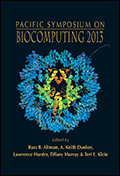Statistical Epistasis Networks Reduce the Computational Complexity of Searching Three-Locus Genetic Models
Ting Hu1, Angeline S. Andrew2, Margaret R. Karagas3, Jason H. Moore4
1Department of Genetics, Geisel School of Medicine Dartmouth College;2Department of Community and Family Medicine, Geisel School of Medicine Dartmouth College3Departments of Genetics and Community and Family Medicine, Geisel School of Medicine Dartmouth College
Email: jason.h.moore@dartmouth.edu
Pacific Symposium on Biocomputing 18:397-408(2013)

Abstract
The rapid development of sequencing technologies makes thousands to millions of genetic at- tributes available for testing associations with various biological traits. Searching this enormous high-dimensional data space imposes a great computational challenge in genome-wide association studies. We introduce a network-based approach to supervise the search for three-locus models of disease susceptibility. Such statistical epistasis networks (SEN) are built using strong pairwise epistatic interactions and provide a global interaction map to search for higher-order interactions by prioritizing genetic attributes clustered together in the networks. Applying this approach to a population-based bladder cancer dataset, we found a high susceptibility three-way model of ge- netic variations in DNA repair and immune regulation pathways, which holds great potential for studying the etiology of bladder cancer with further biological validations. We demonstrate that our SEN-supervised search is able to ?nd a small subset of three-locus models with signi?cantly high associations at a substantially reduced computational cost.
[Full-Text PDF] [PSB Home Page]